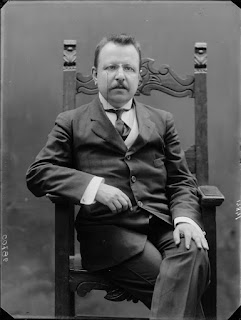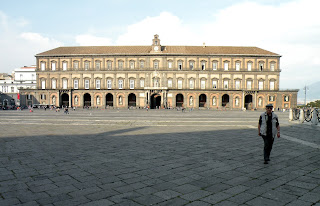Prolific writer opposed the Fascists and supported democracy
 |
| Benedetto Croce influenced literature, philosophy and politics in his lifetime |
Croce was an idealist philosopher, historian and erudite literary scholar whose approach to literature influenced future generations of writers and literary critics. He was nominated for the Nobel Prize in Literature 16 times.
He became a Senator in 1910 and was Minister for Education from 1920 to 1921 in the last pre-Fascist government of the so-called Giolitti era. He is also remembered for his major contribution to the rebirth of Italian democracy after World War II.
Croce was born into a wealthy family and raised in a strict Catholic environment. However, from the age of 16 he gave up Catholicism and developed a personal philosophy of spiritual life.
In 1883, while he was still a teenager, he was on holiday with his family on the island of Ischia when an earthquake struck the town of Casamicciola Terme and destroyed the house they were staying in. His mother, father and sister were all killed, but although he was buried for a long time, he managed to survive.
Croce inherited his family’s fortune and was able to live a life of leisure, devoting his time to philosophy and writing while living in a palazzo in Naples. His ideas began to be publicised at the University of Rome by Professor Antonio Labriola.
After his appointment to the Senate, Croce was a critic of Italy’s involvement in World War I. He left Government office about a year before Benito Mussolini assumed power.
 |
| Benedetto Croce (left), with the first president of the post-War Italian republic, Enrico De Nicola |
After Giacomo Matteotti was assassinated by the Fascists in 1924, Croce was one of the signatories to the manifesto of the anti-Fascist intellectuals and he provided financial support to anti-Fascist writers.
His home and library in Naples were ransacked by the Fascists in 1926 and he was put under surveillance. No mainstream newspaper or academic publication was allowed to refer to him.
Croce kept a diary during World War II entitled ‘Quando l’Italia era tagliato in due (When Italy was cut into two)’.
He made daily entries in this diary between July 1943 and June 1944. He had left his home in Naples, Palazzo Filomarino della Rocca, and gone to Sorrento to escape the Allied air raids.
He was staying in the Villa Tritone, a clifftop residence in Via Marina Grande overlooking the sea. The Germans entered and occupied Naples during September and on 12 September the Germans rescued Mussolini - who had been overthrown by the Fascist Grand Council and held captive - from his prison on Gran Sasso in the mountains of Abruzzo with a glider-borne team.
| The entrance to Villa Tritone on Via Marina Grande in Sorrento, where Croce moved during World War II |
He is advised to leave the Villa Tritone immediately to avoid being taken hostage by Fascists who would use him for propaganda purposes.
The next day’s entry was written by him on Capri. Croce reports that a floating mine was found in the sea below the villa and it was thought the retreating Germans might have been planning to come and take him as they had taken other prominent Italians in Salerno.
A motorboat was sent for him and his daughters from Capri, which was at the time firmly in Allied hands. The family were able to use the stairs that led from Villa Tritone down to the beach to get away. On board were a police commissioner from Capri and an English army officer who had been tasked with rescuing him.
The boat returned to Sorrento later to collect Croce’s wife and another of his daughters who had stayed behind to pack up their possessions. On board were the same police commissioner and Major Munthe, the son of Axel Munthe, the Swedish doctor who was a Capri resident for a large part of his life and was famous for his best-selling memoir, The Story of San Michele. The Fascist and German radio stations broadcast that ‘Croce and others’ were to be severely punished, but the Allies were able to counter this by broadcasting that the philosopher was now safely on Capri.
When democracy was restored in Italy in 1944, Croce became a minister in the governments of Pietro Badoglio and Ivanoe Bonomi.
He voted for the Monarchy in the Constitutional referendum in 1946. He was elected to the Constituent Assembly that existed until 1948 but he declined to stand as provisional president of Italy.
Croce’s philosophical ideas were expressed in more than 80 books and 40 years worth of articles in his own literary magazine, La Critica. His theories were later debated by many Italian philosophers, including Umberto Eco.
Croce was President of PEN International, the worldwide writer’s association, from 1949 until his death in Naples in 1952.
His widow and daughters established the Fondazione Biblioteca Benedetto Croce in the Palazzo Filomarino della Rocca in 1955. The street on which the palazzo stands is now named Via Benedetto Croce.
 |
| The Palazzo Reale in Naples, which houses the Biblioteca Nazionale Vittorio Emanuele III |
The Biblioteca Nazionale Vittorio Emanuele III, a national library of Italy, now occupies the eastern wing of the 18th century Palazzo Reale in Naples as a result of efforts made on its behalf by Benedetto Croce in the 1920s. It houses nearly one and a half million printed volumes, as well as hundreds of thousands of pamphlets, manuscripts and periodicals. The library had been founded in the 18th century in the Palazzo degli Studi but after various collections were added to it, following the suggestion of Croce, the library was moved to Palazzo Reale and installed in accommodation granted to it by King Victor Emmanuel III.
Hotels in Naples from Booking.com
 |
| A plaque on the exterior wall of the Villa Tritone commemorates Croce's stay |
A plaque on the exterior wall of Villa Tritone in Sorrento records the residence there during World War II of Benedetto Croce ‘when Italy was cut in two’. A villa had been built on the site in the first century AD by Agrippa Postumus, grandson of Emperor Augustus, and Ovid was said to have been a frequent visitor. This became the site of a convent in the 13th century and then the land was purchased in the 19th century by Count Labonia and the present villa was built. At the beginning of the 20th century William Waldorf Astor bought the villa and designed the garden behind it with windows cut in the high wall on the seaward side to give views of the sea and Vesuvius across the bay.
Book your stay in Sorrento with Booking.com
More reading:
How Mussolini's thugs kidnapped and murder brave politician Giacomo Matteotti
The controversial general who turned against Mussolini
Political philosopher who defined Right and Left in simple terms
Also on this day:
1626: The death of painter Enea Salmeggia
1683: The birth of pathological anatomist Giovanni Battista Morgagni
1707: The birth of playwright Carlo Goldoni
1873: The birth of opera singer Enrico Caruso
2003: The death of comic actor Alberto Sordi
(Picture credit: Palazzo Reale by Vitold Muratov via Wikimedia Commons)

























